
Hamsters are rodents belonging to the subfamily Cricetinae, which contains 19 species classified in seven genera. They have become established as popular small pets. The best-known species of hamster is the golden or Syrian hamster, which is the type most commonly kept as a pet. Other hamster species commonly kept as pets are the three species of dwarf hamster, Campbell's dwarf hamster, the winter white dwarf hamster and the Roborovski hamster.
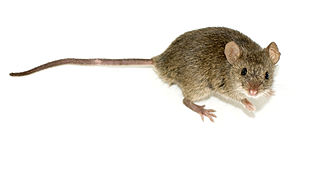
A mouse is a small rodent. Characteristically, mice are known to have a pointed snout, small rounded ears, a body-length scaly tail, and a high breeding rate. The best known mouse species is the common house mouse. Mice are also popular as pets. In some places, certain kinds of field mice are locally common. They are known to invade homes for food and shelter.
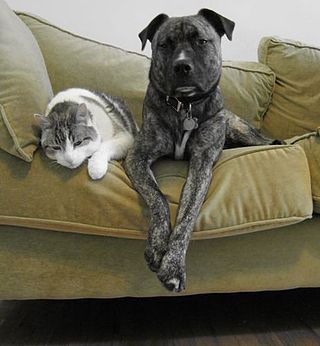
A pet, or companion animal, is an animal kept primarily for a person's company or entertainment rather than as a working animal, livestock, or a laboratory animal. Popular pets are often considered to have attractive/cute appearances, intelligence, and relatable personalities, but some pets may be taken in on an altruistic basis and accepted by the owner regardless of these characteristics.
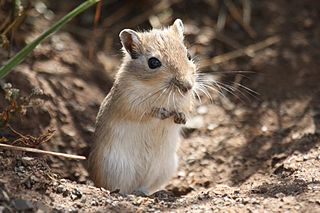
The Mongolian gerbil or Mongolian jird is a rodent belonging to the subfamily Gerbillinae. Their body size is typically 110–135 mm, with a 95–120 mm tail, and body weight 60–130 g, with adult males larger than females. The animal is used in science and research or kept as a small house pet. Their use in science dates back to the latter half of the 19th century, but they only started to be kept as pets in the English-speaking world after 1954, when they were brought to the United States. However, their use in scientific research has fallen out of favor.

Gerbillinae is one of the subfamilies of the rodent family Muridae and includes the gerbils, jirds, and sand rats. Once known as desert rats, the subfamily includes about 110 species of African, Indian, and Asian rodents, including sand rats and jirds, all of which are adapted to arid habitats. Most are primarily active during the day, making them diurnal, and almost all are omnivorous.
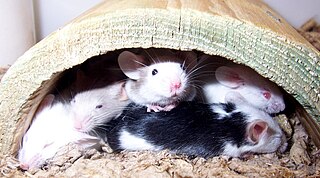
The domestication of small mammals to keep as pets is a relatively recent development, arising only after large-scale industrialization. Historically, Western society was more agrarian than today, with rodents as a whole seen as vermin that were carriers for disease and a threat to crops. Animals that hunted such pests, such as terriers and cats, were prized.

The term spiny mouse refers to any species of rodent within the genus Acomys. Similar in appearance to mice of the genus Mus, spiny mice are small mammals with bare tails which contain osteoderms, a rare feature in mammals. Their coats are endowed with unusually stiff guard hairs similar to the spines of a hedgehog; this trait is the source of the common name, spiny mouse.
The pleasant gerbil is a species of rodent found mainly in Libya and Egypt, and possibly Mauritania to Tunisia. This species is about 6 cm in body length, with a brown agouti-style coat, a white belly and a very long tail. It is also known as the charming dipodil.
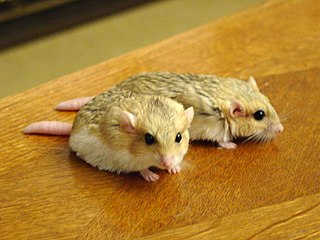
The fat-tailed gerbil, also called the duprasi gerbil or doop, is a rodent belonging to the subfamily Gerbillinae. It is only species in the genus Pachyuromys. They are frequently kept as pets.
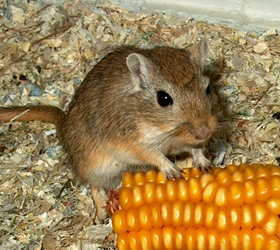
Meriones is a rodent genus that includes the gerbil most commonly kept as a pet, Meriones unguiculatus. The genus contains most animals referred to as jirds, but members of the genera Sekeetamys, Brachiones, and sometimes Pachyuromys are also known as jirds. The distribution of Meriones ranges from northern Africa to Mongolia. Meriones jirds tend to inhabit arid regions including clay desert, sandy desert, and steppe, but are also in slightly wetter regions, and are an agricultural pest.

Taterillus is a genus of rodents. The species within this genus can only be reliably distinguished on the basis of karyotype, and not by external appearance.
Petter's gerbil or Petter's tateril is a species of rodent found in Burkina Faso, Mali, and Niger. Its natural habitats are dry savanna, subtropical or tropical dry shrubland, arable land, and rural gardens.

Hamster balls are hollow spheres made of clear plastic into which hamsters, gerbils, degus and other small rodent pets are placed, allowing them to run around outside their cages without the risk of running away or getting lost under furniture. They are designed to provide hamsters with exercise. Balls produce an audible rumble across most surfaces, making them easier to locate even when out of sight.
T. gracilis may refer to:

Infanticide is the termination of a neonate after it has been born, and in zoology this is often the termination or consumption of newborn animals by either a parent or an unrelated adult. In rodents, it is not uncommon for the mother to commit infanticide shortly after parturition under conditions of extreme stress, or for an unrelated male to kill neonates.
T. nigricauda may refer to:
Rat variety may refer to:











